coolant level FIAT DUCATO BASE CAMPER 2014 Owner handbook (in English)
[x] Cancel search | Manufacturer: FIAT, Model Year: 2014, Model line: DUCATO BASE CAMPER, Model: FIAT DUCATO BASE CAMPER 2014Pages: 367, PDF Size: 20.39 MB
Page 128 of 367
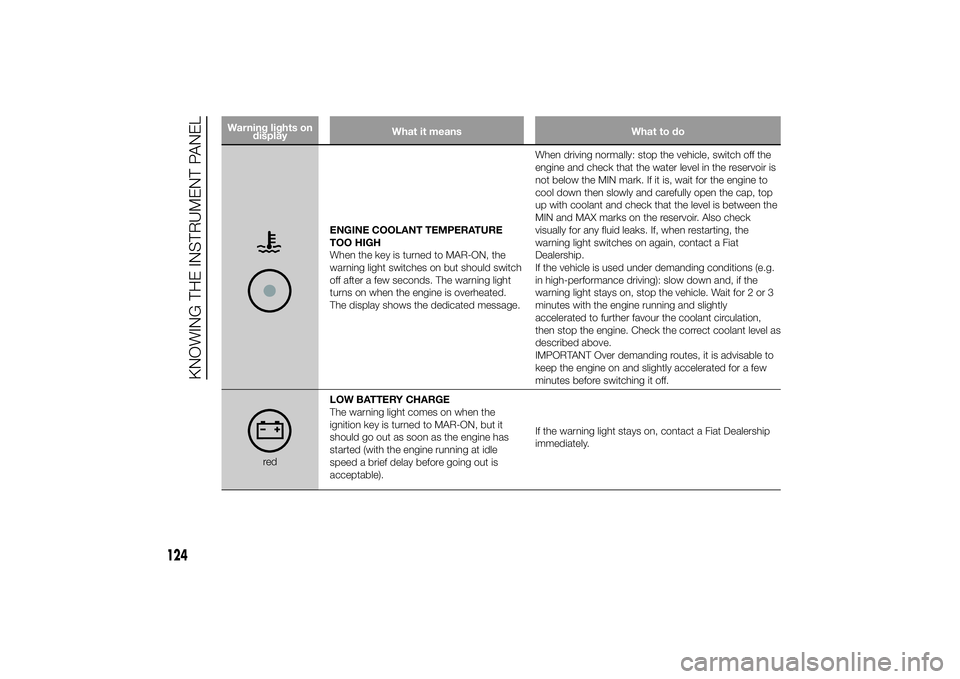
Warning lights on
displayWhat it means What to do
ENGINE COOLANT TEMPERATURE
TOO HIGH
When the key is turned to MAR-ON, the
warning light switches on but should switch
off after a few seconds. The warning light
turns on when the engine is overheated.
The display shows the dedicated message.When driving normally: stop the vehicle, switch off the
engine and check that the water level in the reservoir is
not below the MIN mark. If it is, wait for the engine to
cool down then slowly and carefully open the cap, top
up with coolant and check that the level is between the
MIN and MAX marks on the reservoir. Also check
visually for any fluid leaks. If, when restarting, the
warning light switches on again, contact a Fiat
Dealership.
If the vehicle is used under demanding conditions (e.g.
in high-performance driving): slow down and, if the
warning light stays on, stop the vehicle. Wait for 2 or 3
minutes with the engine running and slightly
accelerated to further favour the coolant circulation,
then stop the engine. Check the correct coolant level as
described above.
IMPORTANT Over demanding routes, it is advisable to
keep the engine on and slightly accelerated for a few
minutes before switching it off.
redLOW BATTERY CHARGE
The warning light comes on when the
ignition key is turned to MAR-ON, but it
should go out as soon as the engine has
started (with the engine running at idle
speed a brief delay before going out is
acceptable).If the warning light stays on, contact a Fiat Dealership
immediately.
124
KNOWING THE INSTRUMENT PANEL
Page 229 of 367
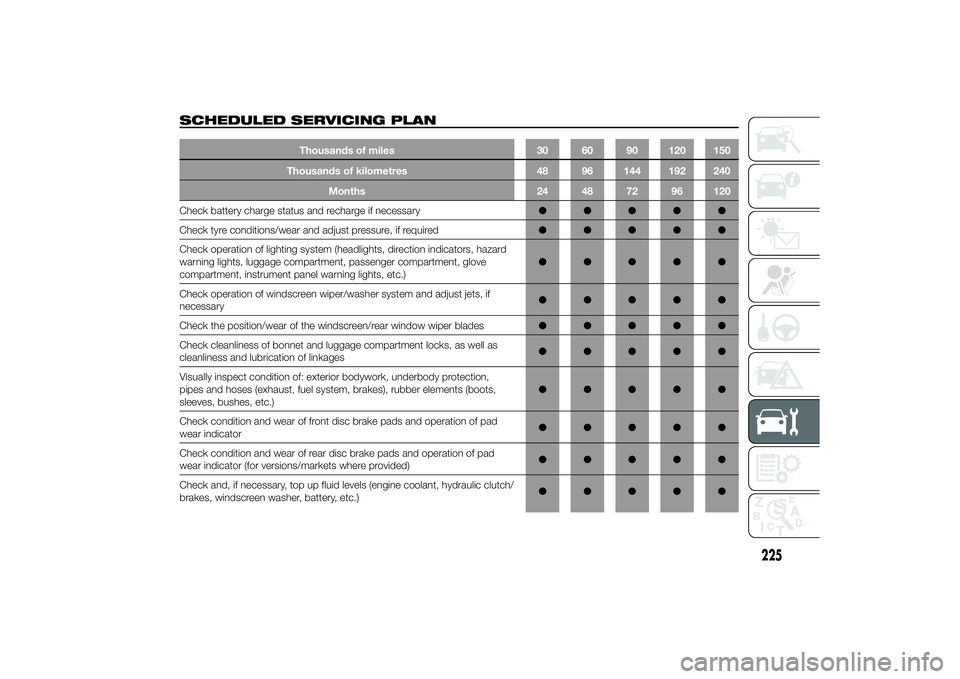
SCHEDULED SERVICING PLAN
Thousands of miles 30 60 90 120 150
Thousands of kilometres 48 96 144 192 240
Months 24 48 72 96 120
Check battery charge status and recharge if necessary●●●●●
Check tyre conditions/wear and adjust pressure, if required●●●●●
Check operation of lighting system (headlights, direction indicators, hazard
warning lights, luggage compartment, passenger compartment, glove
compartment, instrument panel warning lights, etc.)●●●●●
Check operation of windscreen wiper/washer system and adjust jets, if
necessary●●●●●
Check the position/wear of the windscreen/rear window wiper blades●●●●●
Check cleanliness of bonnet and luggage compartment locks, as well as
cleanliness and lubrication of linkages●●●●●
Visually inspect condition of: exterior bodywork, underbody protection,
pipes and hoses (exhaust, fuel system, brakes), rubber elements (boots,
sleeves, bushes, etc.)●●●●●
Check condition and wear of front disc brake pads and operation of pad
wear indicator●●●●●
Check condition and wear of rear disc brake pads and operation of pad
wear indicator (for versions/markets where provided)●●●●●
Check and, if necessary, top up fluid levels (engine coolant, hydraulic clutch/
brakes, windscreen washer, battery, etc.)●●●●●
225
Page 232 of 367
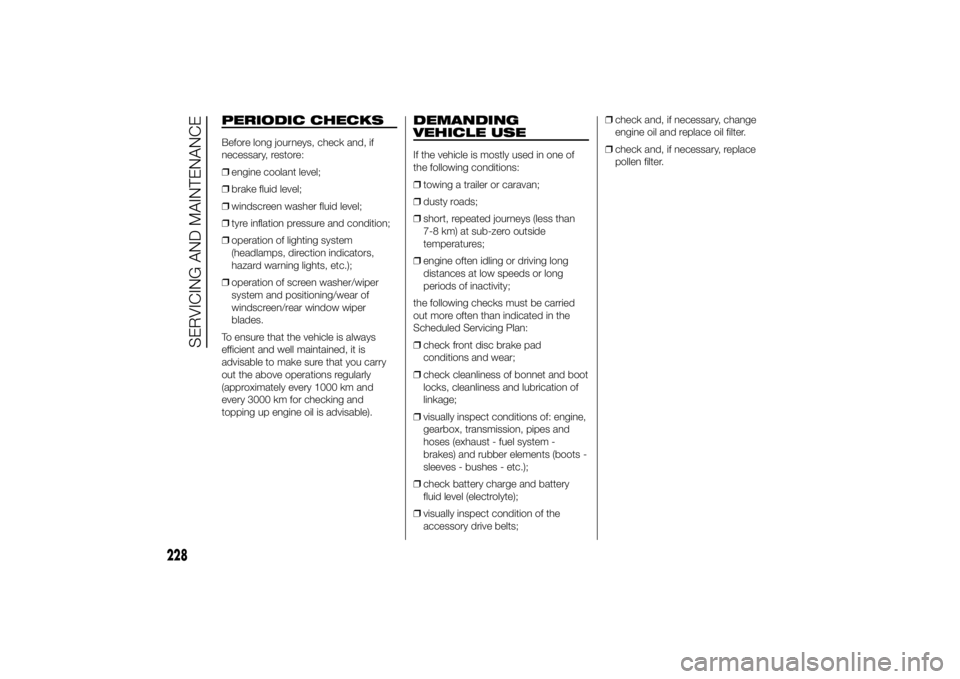
PERIODIC CHECKSBefore long journeys, check and, if
necessary, restore:
❒engine coolant level;
❒brake fluid level;
❒windscreen washer fluid level;
❒tyre inflation pressure and condition;
❒operation of lighting system
(headlamps, direction indicators,
hazard warning lights, etc.);
❒operation of screen washer/wiper
system and positioning/wear of
windscreen/rear window wiper
blades.
To ensure that the vehicle is always
efficient and well maintained, it is
advisable to make sure that you carry
out the above operations regularly
(approximately every 1000 km and
every 3000 km for checking and
topping up engine oil is advisable).
DEMANDING
VEHICLE USEIf the vehicle is mostly used in one of
the following conditions:
❒towing a trailer or caravan;
❒dusty roads;
❒short, repeated journeys (less than
7-8 km) at sub-zero outside
temperatures;
❒engine often idling or driving long
distances at low speeds or long
periods of inactivity;
the following checks must be carried
out more often than indicated in the
Scheduled Servicing Plan:
❒check front disc brake pad
conditions and wear;
❒check cleanliness of bonnet and boot
locks, cleanliness and lubrication of
linkage;
❒visually inspect conditions of: engine,
gearbox, transmission, pipes and
hoses (exhaust - fuel system -
brakes) and rubber elements (boots -
sleeves - bushes - etc.);
❒check battery charge and battery
fluid level (electrolyte);
❒visually inspect condition of the
accessory drive belts;❒check and, if necessary, change
engine oil and replace oil filter.
❒check and, if necessary, replace
pollen filter.
228
SERVICING AND MAINTENANCE
Page 233 of 367
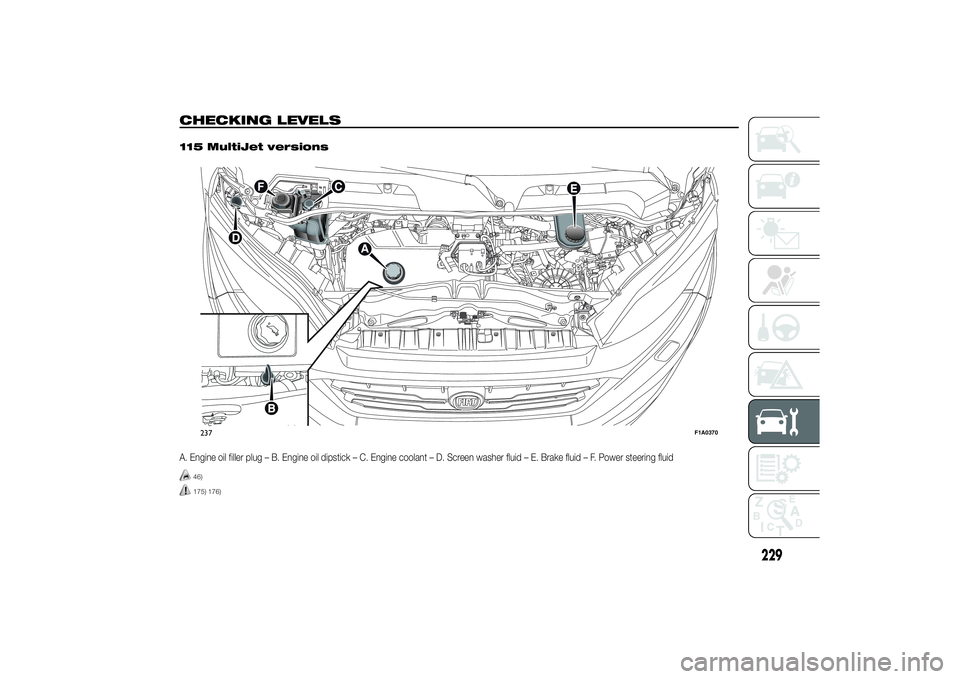
CHECKING LEVELS
.
115 MultiJet versionsA. Engine oil filler plug – B. Engine oil dipstick – C. Engine coolant – D. Screen washer fluid – E. Brake fluid – F. Power steering fluid
46)175) 176)237
F1A0370
229
Page 236 of 367
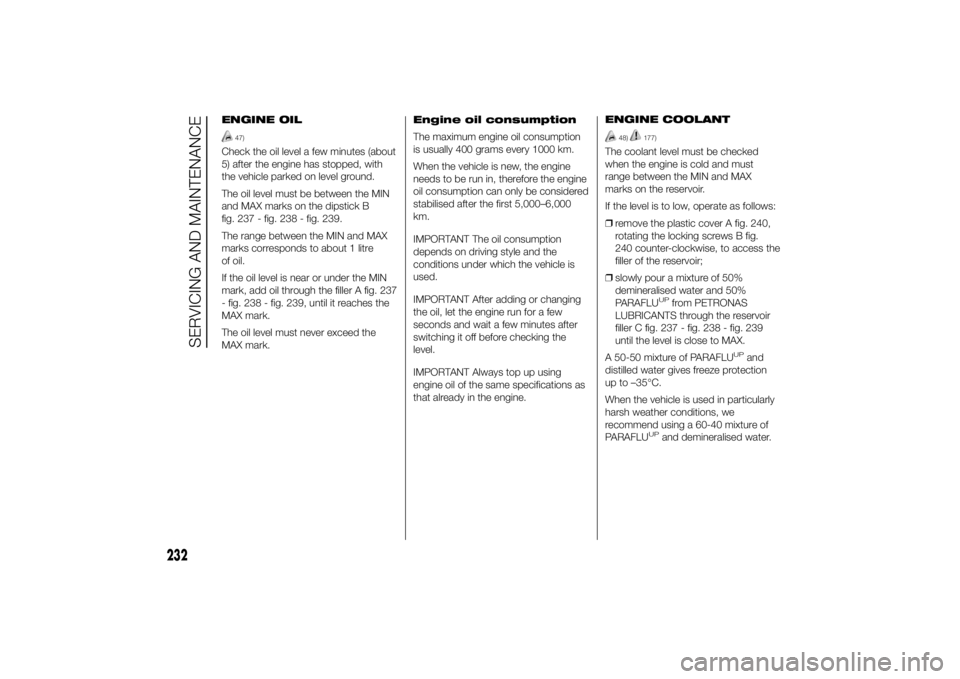
ENGINE OIL
47)
Check the oil level a few minutes (about
5) after the engine has stopped, with
the vehicle parked on level ground.
The oil level must be between the MIN
and MAX marks on the dipstick B
fig. 237 - fig. 238 - fig. 239.
The range between the MIN and MAX
marks corresponds to about 1 litre
of oil.
If the oil level is near or under the MIN
mark, add oil through the filler A fig. 237
- fig. 238 - fig. 239, until it reaches the
MAX mark.
The oil level must never exceed the
MAX mark.Engine oil consumption
The maximum engine oil consumption
is usually 400 grams every 1000 km.
When the vehicle is new, the engine
needs to be run in, therefore the engine
oil consumption can only be considered
stabilised after the first 5,000–6,000
km.
IMPORTANT The oil consumption
depends on driving style and the
conditions under which the vehicle is
used.
IMPORTANT After adding or changing
the oil, let the engine run for a few
seconds and wait a few minutes after
switching it off before checking the
level.
IMPORTANT Always top up using
engine oil of the same specifications as
that already in the engine.ENGINE COOLANT
48)
177)
The coolant level must be checked
when the engine is cold and must
range between the MIN and MAX
marks on the reservoir.
If the level is to low, operate as follows:
❒remove the plastic cover A fig. 240,
rotating the locking screws B fig.
240 counter-clockwise, to access the
filler of the reservoir;
❒slowly pour a mixture of 50%
demineralised water and 50%
PARAFLU
UP
from PETRONAS
LUBRICANTS through the reservoir
filler C fig. 237 - fig. 238 - fig. 239
until the level is close to MAX.
A 50-50 mixture of PARAFLU
UP
and
distilled water gives freeze protection
up to –35°C.
When the vehicle is used in particularly
harsh weather conditions, we
recommend using a 60-40 mixture of
PARAFLU
UP
and demineralised water.
232
SERVICING AND MAINTENANCE
Page 363 of 367
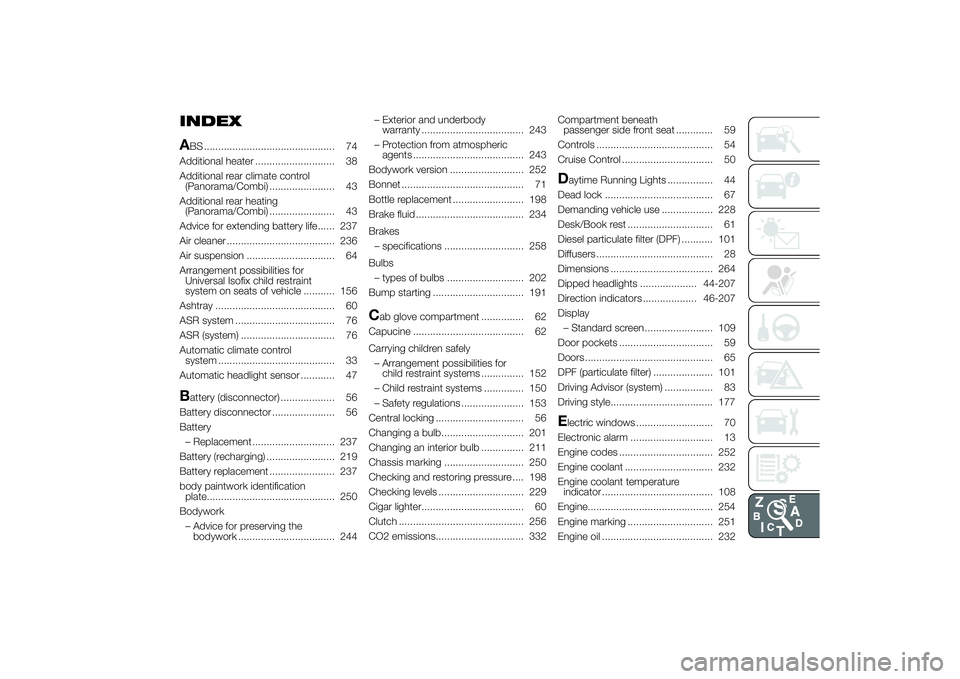
INDEX
ABS .............................................. 74
Additional heater ............................ 38
Additional rear climate control
(Panorama/Combi) ....................... 43
Additional rear heating
(Panorama/Combi) ....................... 43
Advice for extending battery life...... 237
Air cleaner ...................................... 236
Air suspension ............................... 64
Arrangement possibilities for
Universal Isofix child restraint
system on seats of vehicle ........... 156
Ashtray .......................................... 60
ASR system ................................... 76
ASR (system) ................................. 76
Automatic climate control
system ......................................... 33
Automatic headlight sensor ............ 47Battery (disconnector) ................... 56
Battery disconnector ...................... 56
Battery
– Replacement ............................. 237
Battery (recharging) ........................ 219
Battery replacement ....................... 237
body paintwork identification
plate............................................. 250
Bodywork
– Advice for preserving the
bodywork .................................. 244– Exterior and underbody
warranty .................................... 243
– Protection from atmospheric
agents ....................................... 243
Bodywork version .......................... 252
Bonnet ........................................... 71
Bottle replacement ......................... 198
Brake fluid ...................................... 234
Brakes
– specifications ............................ 258
Bulbs
– types of bulbs ........................... 202
Bump starting ................................ 191
Cab glove compartment ............... 62
Capucine ....................................... 62
Carrying children safely
– Arrangement possibilities for
child restraint systems ............... 152
– Child restraint systems .............. 150
– Safety regulations ...................... 153
Central locking ............................... 56
Changing a bulb............................. 201
Changing an interior bulb ............... 211
Chassis marking ............................ 250
Checking and restoring pressure .... 198
Checking levels .............................. 229
Cigar lighter.................................... 60
Clutch ............................................ 256
CO2 emissions............................... 332Compartment beneath
passenger side front seat ............. 59
Controls ......................................... 54
Cruise Control ................................ 50
Daytime Running Lights ................ 44
Dead lock ...................................... 67
Demanding vehicle use .................. 228
Desk/Book rest .............................. 61
Diesel particulate filter (DPF) ........... 101
Diffusers ......................................... 28
Dimensions .................................... 264
Dipped headlights .................... 44-207
Direction indicators ................... 46-207
Display
– Standard screen ........................ 109
Door pockets ................................. 59
Doors ............................................. 65
DPF (particulate filter) ..................... 101
Driving Advisor (system) ................. 83
Driving style.................................... 177Electric windows ........................... 70
Electronic alarm ............................. 13
Engine codes ................................. 252
Engine coolant ............................... 232
Engine coolant temperature
indicator ....................................... 108
Engine............................................ 254
Engine marking .............................. 251
Engine oil ....................................... 232